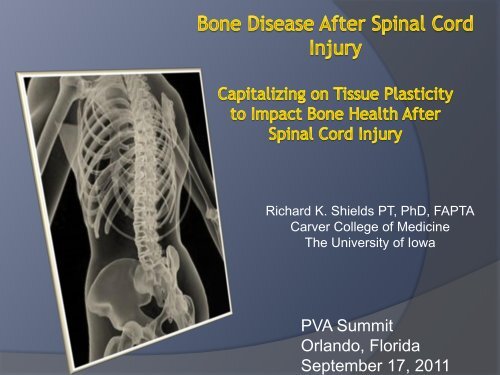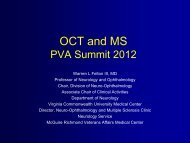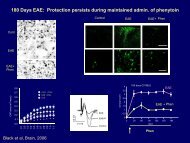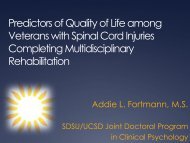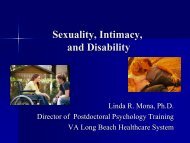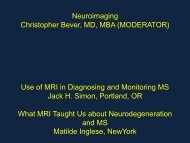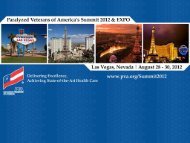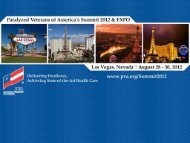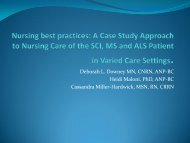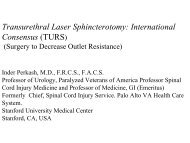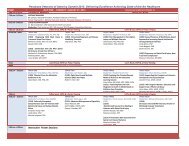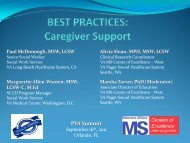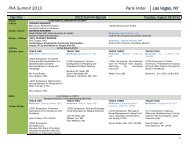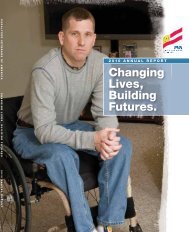Richard Shields, PhD, PT
Richard Shields, PhD, PT
Richard Shields, PhD, PT
Create successful ePaper yourself
Turn your PDF publications into a flip-book with our unique Google optimized e-Paper software.
<strong>Richard</strong> K. <strong>Shields</strong> <strong>PT</strong>, <strong>PhD</strong>, FA<strong>PT</strong>A<br />
Carver College of Medicine<br />
The University of Iowa<br />
PVA Summit<br />
Orlando, Florida<br />
September 17, 2011
Disclosures<br />
Dr. <strong>Shields</strong> has no financial relationship<br />
with any private or public corporations.<br />
Dr. <strong>Shields</strong> and the University of Iowa<br />
received a patent on technology<br />
developed as part of his research<br />
program.
Colleagues:<br />
Shauna Dudley-Javoroski <strong>PT</strong>, <strong>PhD</strong><br />
Manish Suneja MD, <strong>PhD</strong><br />
Erwei Bei <strong>PhD</strong><br />
Elizabeth Faidley BA<br />
Brandon Campbell<br />
David Gerleman BA<br />
Jason Wu MSE<br />
Shih-Chiao Tseng <strong>PT</strong>, <strong>PhD</strong><br />
Punam Saha <strong>PhD</strong><br />
Robert Phillibert MD, <strong>PhD</strong><br />
Chris Adams MD, <strong>PhD</strong><br />
Heather Bingham MD<br />
Ellen Cloyed MSW<br />
Donna Healy RN<br />
Terry Clark PA<br />
Patrick Johnston D<strong>PT</strong><br />
Acknowledgements<br />
Deb Givens Heiss<br />
The Ohio State University<br />
Andrew Meszaros<br />
University of Toledo<br />
Sheila Schindler-Ivens<br />
Marquette University<br />
Laura Frey Law<br />
University of Iowa<br />
Students:<br />
Amy Kimball <strong>PT</strong><br />
Andy Littmann <strong>PT</strong>, c<strong>PhD</strong><br />
Michael Petrie BSE<br />
Colleen McHenry MSE<br />
Michael Shaffer M<strong>PT</strong><br />
Preeti Deshpande<br />
University of California Fresno<br />
Bryon Ballantyne<br />
Saint Ambrose University<br />
Kim Eppen<br />
University of Iowa<br />
Hospitals and Clinics<br />
Sangeetha Madhavan<br />
Northwestern University<br />
Support:<br />
NIH: R01 NR23316, R01 HD69843,<br />
R01HD452361, Dept of Veterans Affairs,<br />
Reeve Foundation, Neilsen Foundation,<br />
Spinal Cord Foundation, Foundation <strong>PT</strong><br />
Ya-Ju Chang<br />
Gung Chung<br />
University<br />
Nora Riley<br />
Saint Ambrose University<br />
Masaki Iguchi<br />
Tsukuba University<br />
Shauna Dudley-<br />
Javoroski<br />
University of Iowa<br />
3
Prevalence and Cost<br />
Spinal cord injury (SCI) impacts ~ two hundred<br />
thousand individuals and costs society ~ 5 billion<br />
dollars annually 1 .<br />
Muscle atrophies quickly and bone mass begins to<br />
decline at a rate of 2-4% per month 2<br />
The hazard for mortality is estimated to be 78%<br />
higher for people with SCI who sustain a lower<br />
extremity fracture 3 .<br />
1. Stover SL, DeLisa JS, Whiteneck GG. Spinal cord injury: Clinical outcomes from the model systems. Gaithersburg, MD: Aspen Publishers, Inc.; 1995.<br />
2. Wilmet E, Ismail AA, Heilporn A, Welraeds D, Bergmann P. Longitudinal study of the bone mineral content and of soft tissue composition after spinal<br />
cord section. Paraplegia 1995;33:674-677.<br />
3. Krause JS, Carter RE, Pickelsimer EE, Wilson D. A prospective study of health and risk of mortality after spinal cord injury. Arch Phys Med Rehabil<br />
2008;89:1482-1491.
Objectives of Presentation<br />
Attendees will become aware of our work<br />
exploring mechanical methods to prevent bone<br />
loss in humans with SCI.<br />
Attendees will appreciate issues of doseresponse,<br />
feasibility, and outcomes of timely<br />
delivered stress in humans with SCI.<br />
Attendees will understand the complexities of<br />
mechanisms that contribute to osteogenic<br />
responses in humans with SCI.
Example: Post-SCI bone loss<br />
Left Distal Tibia:<br />
Left Distal Tibia:<br />
16 mos. Post-SCI<br />
6 mos. Post-SCI<br />
BMD: 46% loss<br />
BMD: 9% loss<br />
3.5 yrs.<br />
Post-SCI<br />
BMD: 63%<br />
loss<br />
6
Bone Loss and Complications<br />
Fractures<br />
Kidney Stones<br />
C
Musculoskeletal Deterioration<br />
<strong>Shields</strong> RK, Physical Therapy 2003<br />
8
What is the Mechanism of Bone Loss<br />
After SCI?<br />
Endocrine?<br />
Mechanical?<br />
Neural?<br />
Vascular?<br />
9
Influences on bone<br />
Genetics<br />
Endocrine<br />
Neural<br />
Mechanical<br />
Qin, Bauman, Cardoza, 2010
Mechanical<br />
Active<br />
• Muscle (force/load dependent)<br />
○ Requires electrical stimulation (nerve)<br />
○ Dose<br />
Passive<br />
• Vibration<br />
• Standing with no muscle force<br />
• Braces<br />
○ Dose<br />
All methods involve upregulated/down<br />
regulated molecular signaling pathways
Muscle as a Master Organ:<br />
Mechanical, Neural, Vascular, Endocrine<br />
Recent SCI<br />
3 Days<br />
Chronic SCI<br />
1 year
Regular Muscle Activity<br />
PGC1 alpha<br />
Torque/Force<br />
Fast Myosin<br />
Eccentric<br />
Myostatin<br />
Concentric<br />
Slow Myosin<br />
Isometric<br />
IGF-1 Mitochondria Glucose<br />
13
Force – Velocity Curve for Muscle<br />
14
Repetitive<br />
Velocity<br />
Transducer<br />
Load<br />
Length<br />
concentric<br />
Bone<br />
Nerve<br />
eccentric<br />
isometric<br />
Muscle<br />
Work Rest Cycle<br />
15
Study 1: Can Mechanical Stress through<br />
Muscle Contraction Prevent Bone Changes<br />
after SCI?<br />
Started within 6 weeks post SCI.<br />
Trained one leg for 2+ years (N=10)<br />
Intervention: 35 minutes/day electrical<br />
stimulation; Dose Specific<br />
Compliance: 82% J Neuro-rehab 2007<br />
Spine 2006<br />
Muscle and Nerve 2006<br />
J Neurophys 2006<br />
J Appl Physiol 2006<br />
J Appl Physiol 2008<br />
Osteopororsis Int 2010<br />
Neuroscience Letters 2011<br />
Arch Phys Med 2011
Rationale for the Intervention?<br />
Muscle stress<br />
Bone stress<br />
Frequency<br />
Current<br />
Work-rest<br />
Adherence<br />
1-1.5 times<br />
Body weight
Within Subject Control<br />
Systemic Factors
After 3 Years….<br />
Untrained<br />
Trained<br />
40% increase
Torque<br />
Integral (Nm*ms)<br />
3500<br />
3000<br />
2500<br />
2000<br />
1500<br />
untrained<br />
trained<br />
**<br />
*<br />
†<br />
}<br />
§<br />
1000<br />
1 2 3 4 5 6<br />
Time Bins<br />
‡<br />
T1= < 6 wks; T2=.5 years; T3=1 year; T4=1.5 years; T5=2.0; T6=2+<br />
<strong>Shields</strong> et al. J. Neurophysiol. 2006
Bone Density (pQCT) Untrained<br />
versus Trained<br />
Tibia Bone Density<br />
350<br />
300<br />
able bodied<br />
sci<br />
bone density (grms/cm3)<br />
250<br />
200<br />
150<br />
100<br />
50<br />
0<br />
Tibia<br />
Left Leg-Untrained<br />
Right Leg-Trained<br />
32% greater BMD<br />
<strong>Shields</strong> RK…J Neurophysiol. 2006
Untrained<br />
Neural?<br />
Muscle Cytokines?<br />
Mechanical?<br />
Trained<br />
22
Muscle-Bone Signaling<br />
Hamrick et al. 2011
Down Regulated MSTN Gene<br />
24
Muscle and Nerve, 2011
Oxidative Phosphorylation Signaling<br />
Pathway
Activating muscle to stress<br />
bone in stance?<br />
Safer? Feasible?<br />
Benefits? (Psychological, bladder , skin)<br />
Multi-segmental?<br />
Passive, Active, Active Resistive<br />
Stance?
Methodology<br />
5 Groups: 3 yrs<br />
N=32<br />
1. No SCI<br />
2. Acute<br />
3. Hi: 100% X BW<br />
4. Low: 40% X BW<br />
5. Untrained: No<br />
stand<br />
<strong>Shields</strong> et al. Clinical Biomechanics, 2004<br />
28
No SCI<br />
Acute<br />
Hi<br />
Low<br />
Untrained<br />
Osteoporosis International, 2011 in press<br />
29
Unilateral 30 Minutes/Day<br />
Trained<br />
Untrained<br />
Trained 27% larger than Untrained
Untrained vs Trained<br />
NOTE: Untrained received passive standing: 40% of body weight<br />
31
CT<br />
VTA Technique<br />
Volumetric<br />
Topological<br />
Analysis<br />
32
9<br />
8<br />
7<br />
6<br />
5<br />
4<br />
3<br />
2<br />
1
Take Home Message<br />
<br />
Muscle contractions induce important mechanical signals to the skeletal<br />
system of individuals with SCI.<br />
The greater the mechanical signal, the greater the effect on bone. ~<br />
150% of BW compressive load from muscle contraction appears<br />
effective in reducing bone loss in areas that are stressed.<br />
<br />
<br />
<br />
There are minimal systemic effects (paracrine) on bone with localized<br />
stimulation, but large localized effects which appear to be due to<br />
load/electrical activation of tissue.<br />
When contrasted with the literature for cycling, the magnitude of effect<br />
for bone appears enhanced when muscle force is optimized through<br />
isometric contractions.<br />
More research is needed to develop feasible activity based<br />
interventions with the appropriate dose to sustain the health of the<br />
musculoskeletal extremities of people with SCI.
Thank you<br />
richard-shields@uiowa.edu
Unilateral Training<br />
37


